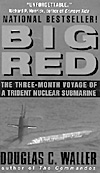 Big Red: The Three-Month Voyage of a Trident Nuclear Submarine, by Douglas C. Waller, HarperTorch (paperback edition), 2002, $7.99, ISBN 0380820781
Big Red: The Three-Month Voyage of a Trident Nuclear Submarine, by Douglas C. Waller, HarperTorch (paperback edition), 2002, $7.99, ISBN 0380820781
I went to a local library looking for a book on ballistic missile submarine operations and was thrilled with what I found. I learned a lot, most of all that a deterrence patrol is not just ‘boring holes in the water'. Technical and tactical details are discussed as are personal stories and personalities. Annoyingly, throughout the book the author refers to the USS Nebraska (SSBN-739) as a Trident submarine. It is an Ohio class which carries Trident missiles armed with about 120 nuclear warheads.
Mr. Waller, an experienced author, has written similar books, including The Commandos, about American special operations forces, and Air Warriors: The Inside Story of the Making of a Navy Pilot. He is always and accurate and thorough observer. Here he gives a brief, but not morbid description of effects of nuclear weapons and potential numbers of people that could be killed, as well as the history of nuclear subs. He then describes how the crew and officers feel about their mission. There are long days with little sleep, especially in the early part of the patrol. There are lots of drills. Standards are high and perfection is the benchmark. Battle training drills included fire, smoke, flooding, use of special breathing equipment, damage control, security violations, decoding coded launch orders, and launching torpedoes and missiles.
Once on patrol, things like discipline and dress are more casual than normal Navy life. Naturally the there is little space on board, but the crew have respect for each other (perhaps enforced) . At the start of the patrol there was a lot of sickness. Germs pass quickly from being close to each other in a sealed environment. There were two real medical emergencies: appendicitis and a kidney ailment. Both were treated by the sub’s medic with radio help from shore and both men were transported off when it was practical, but the well-being of the men was never compromised by the operation of the sub. Things were harder in such cases years ago.
There have been a few changes since the Cold War patrols.
The Ohios are becoming more multi-role now, They might be sent into harm’s way instead of away from it. They perform ASW training, acting as rabbit for fast attacks, ships and aircraft. But the drills and simulations also include limited and full nuclear strikes, firing their ballistic missiles and of course boring deterrence patrols. The crew are under no illusions as to Nebraska’s purpose.
The book stresses Navy people and training over equipment e. g., sonar is an art, as is fast TMA. Speed in damage control is crucial. There are also many examples of the high quality of Navy personnel, being hard-working, dedicated and intelligent. The book also emphasizes the importance of officers and chiefs, how little the junior officers know and how much they rely on the experienced sailors. And while deploying is hard work, morale is high and people are motivated, but towards the end of the patrol, crew morale drops and men begin shouting, snapping, and grumbling with each other. Three months is about as much as most are able to reasonably take.
There is no doubt that sea duty is tough. There are long hours of hard work and constant vigilance, as well as qualification exams, but they also find time to have fun, like the halfway night party and theme nights, good food and videos from wives, and even a barbecue on the deck, called a “steel beach.” There is a high rate of divorce in the submarine service, and a major part must be the shock of a returning husband like a visitor after three months of total absence, however there is a lot of Navy and officer support for wives at home. The Nebraska family extends onto shore as well.
Mr. Waller is an excellent writer, and provides a vivid “fly on the wall” viewpoint that combines detail with perspective. I highly recommend the book to anyone interested in modern submarine operations.
BT
Back to The Naval Sitrep # 26 Table of Contents
Back to Naval Sitrep List of Issues
Back to MagWeb Master Magazine List
& copy Copyright 2004 by Larry Bond and Clash of Arms.
This article appears in MagWeb.com (Magazine Web) on the Internet World Wide Web.
Other military history and related articles are available at http://www.magweb.com